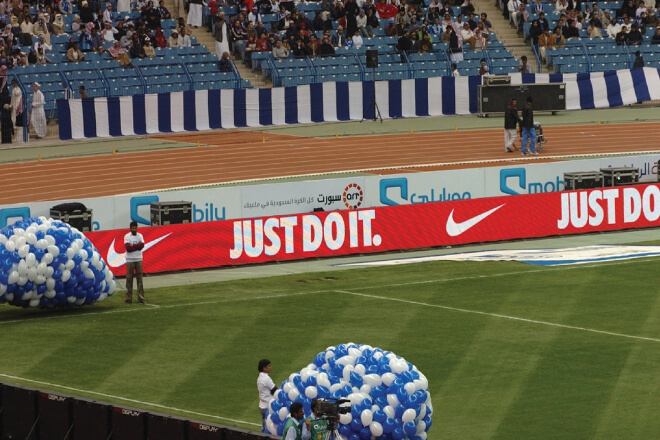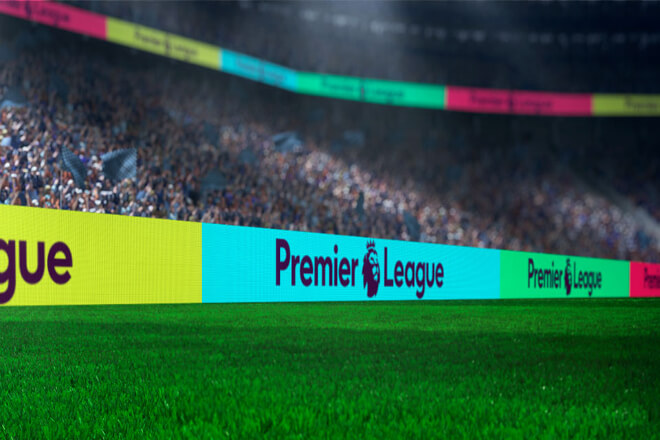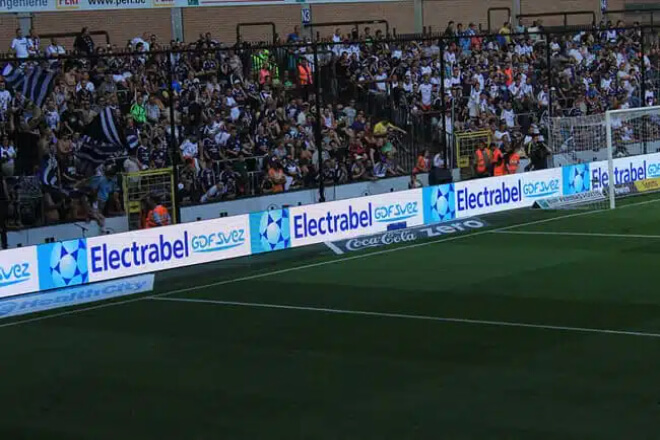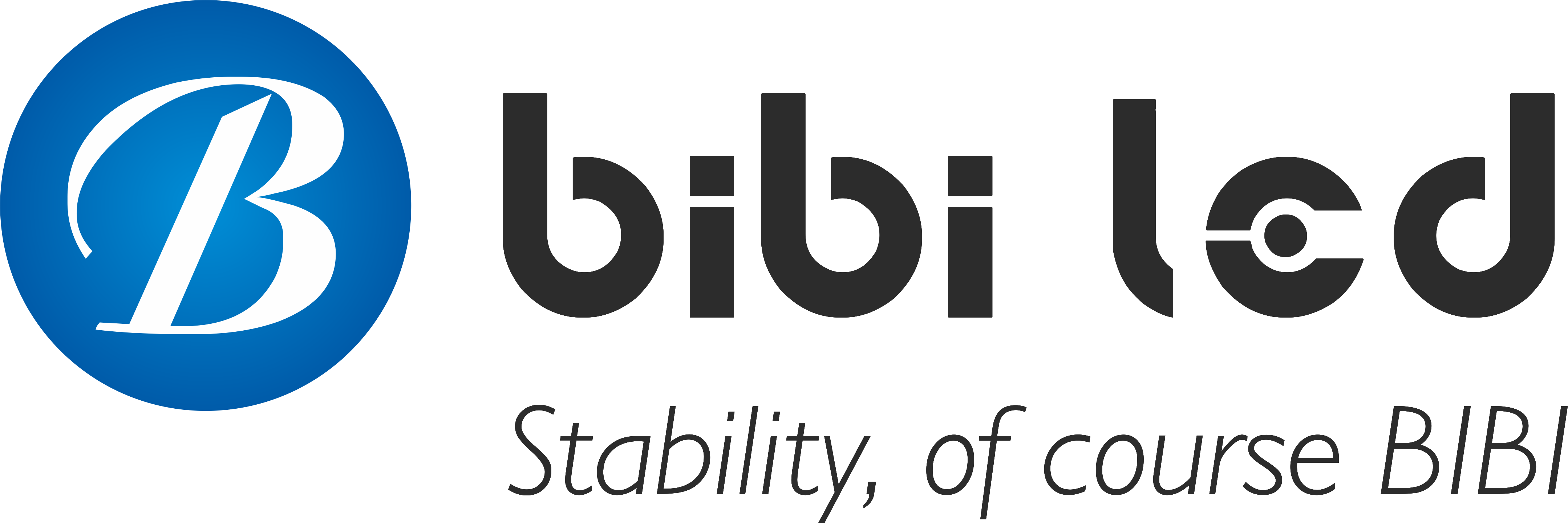Introduction
Perimeter LED screens have become an indispensable part of today’s sporting events and large-scale events.
Have you ever wondered how many clever strategies and meticulous designs are hidden behind those gleaming LED screens on the field?
Today, let’s delve into the world of perimeter LED screens and see how they stand out from the competition and become a powerful tool for brand exposure.
Table of Contents
1. Why Increase the Visibility of perimeter LED screens?

1) Visibility Determines Advertising Value
Installing an perimeter LED screen doesn’t guarantee that anyone will notice it. Just like putting up a beautiful billboard on the side of the road, if no one sees it, the money is wasted.
Increasing visibility means getting more people to see and remember your brand, which naturally increases the value of the advertising space.
2) Capturing the Audience’s Attention
perimeter LED screens are often located on the periphery, where the audience’s attention may be focused on the competition or other activities.
Brighten the screen, animate it, or use some creative touches to draw people in for a few more glances. This will subtly convey your brand message.
3) Make People Stay
Exposure isn’t just about being seen; it’s about staying in view for a few seconds.
For example, if the perimeter LED screen lights up with interactive content at the moment a goal is scored, viewers will look at it a few more times.
These extra glances make your brand more memorable, and that’s the true purpose of advertising.
4) Interact with the Atmosphere
A good perimeter LED screen isn’t just about advertising; it can also participate in the atmosphere.
At concerts, sports events, or festivals, the screen interacts with the rhythm, lighting, and even sound, naturally integrating the message into the scene, enhancing the audience experience and making the brand more present.
5) Enhance the Venue’s Class
Eye-catching perimeter LED screens can make the entire venue look more modern and technological.
Whether it’s a stadium, exhibition, or shopping mall, highly visible LED screens create a professional and upscale atmosphere, making it easier to attract sponsors and partners.
2. Key Strategies for perimeter LED screens to Increase Sponsor Exposure

In modern sporting events and large-scale events, perimeter LED screens have become a crucial tool for sponsors to gain exposure.
However, screens alone aren’t enough; the right approach is crucial for ensuring a brand’s presence is truly memorable.
Key strategies for increasing sponsor exposure can be addressed in 3 key areas: content optimization, technological upgrades, and enhanced interactivity.
1) Content Optimization: Bringing Brands to Life
Content is the first step in attracting viewers to perimeter LED screens. Telling the sponsor’s brand story through the screen can resonate emotionally with viewers, going beyond simply seeing a logo.
Additionally, using dynamic effects to showcase product features or usage scenarios allows viewers to instantly understand the product’s value, which is more eye-catching than simple images or text.
Adding creative advertising design, integrating the event theme and audience interests with brand content, creates a novel and unique visual experience, making it easier for viewers to remember your brand.
2) Technological Upgrades: Ensure “Clear and Enjoyable” Exposure
Even the most engaging content can be significantly undermined if the perimeter LED screen displays poorly.
High resolution and a high refresh rate are essential requirements to ensure clear and smooth advertising.
Intelligent control systems can update advertising content in real time, enabling precise delivery and ensuring every second of screen time is maximized.
Additionally, enhanced environmental adaptability allows the screen to operate stably even in strong sunlight, rain.
Or other challenging conditions, ensuring uninterrupted brand exposure and effective advertising.
3) Enhanced interactivity allows audience participation.
Interaction is a powerful tool for enhancing brand recall. Activities like audience voting and raffles can directly capture audience attention and increase dwell time.
Adding social media interaction, by displaying audience comments, shares, and likes on the screen in real time, can rapidly expand brand reach.
Designing interactive mini-games related to the sponsor’s brand not only enhances engagement but also creates a lasting impression of the brand through the audience’s enjoyment.
Through these three strategies, perimeter LED screens not only showcase the sponsor’s brand but also deeply embed the brand image in the audience’s minds, achieving truly effective exposure.
3. Specific Implementation Steps and Methods

For perimeter LED screens to truly be effective, the key lies not only in strategy but also in implementing each step in a well-organized manner.
The entire process can be divided into three phases: pre-planning, mid-term execution, and post-event evaluation. Let’s take a look at the on-site operations.
Before the event begins, the team is like doing detective work. They conduct market research to understand audience preferences and the content they’re most sensitive to.
For example, football fans tend to focus on team information, while festival-goers are more drawn to interactive games.
These factors influence the content and presentation of advertisements.
Next comes equipment selection: You wouldn’t use a small screen for a large venue, nor would you buy a large screen for a small event.
Therefore, you need to choose the most appropriate perimeter LED screen based on the venue and budget.
Finally, content design: A professional design team will be hired to integrate the brand story, product features.
And the venue’s atmosphere, creating dynamic effects that will captivate the audience from the moment they enter.
On the day of the event, the entire venue resembled a precision machine. Technicians first installed and debugged the equipment, ensuring that each screen was stable and the image was clear and smooth.
After the content launch begins, the team needs to update the screen content based on the progress of the game or the atmosphere at the event.
For example, a brand animation might be displayed at the moment a goal is scored, or the screen might switch to a dazzling color effect at the climax of a music festival.
Interactive activities also take place simultaneously: staff organize audience voting, raffles, or mini-games.
As the audience engages with the information displayed on the perimeter LED screen, the brand naturally becomes ingrained in their minds.
Throughout the entire process, everyone has a clear division of labor to ensure a seamless integration of advertising and interactive activities.
The end of the event doesn’t mean the work is complete. The team begins collecting data: screen impressions, audience engagement rates, and real-time feedback on social media.
Then, they analyze and evaluate the content to determine which content is most engaging and which interactions are most effective.
These insights will serve as a reference for future events, ensuring that each perimeter LED screen deployment is more precise and efficient.
4. Points to note

When using perimeter LED screens to increase sponsorship exposure, certain small details are crucial.
Getting them right can greatly increase the effectiveness, while overlooking them can compromise results. Let’s illustrate these with some practical examples.
1) Safety and stability are paramount.
Although perimeter LED screens are impressive, they are also quite heavy and tall.
For example, at a stadium, a screen swayed slightly in strong winds due to an unreinforced support. Although no one was injured, the event was nearly suspended.
During installation, ensure the support is stable and the power supply is secure to prevent accidents.
Safety is paramount; no matter how impressive the advertising is, it cannot outweigh safety hazards.
2) Avoid overly complex or overly flashy content.
Even if an perimeter LED screen is large, if the content is too complex or flickers excessively, it can be difficult for the audience to see.
For example, at a music festival, a sponsor’s screen displayed its brand logo, product images, QR codes, and dynamic subtitles simultaneously, resulting in the audience being unable to grasp the key points.
In contrast, simple and clear ads, such as those showcasing only the product and a creative slogan, are more likely to capture the brand’s message.
3) Pay attention to brightness and environmental adaptability.
Bright daylight, nighttime lighting, and rainy weather can all affect the screen’s performance.
For example, during a marathon, strong morning sunlight made the advertising content nearly indistinguishable on an perimeter LED screen that wasn’t properly adjusted.
Later, by adjusting the brightness and adding waterproofing measures, the results were significantly improved.
Ensuring the stable operation of the screen in various environments is crucial for effective exposure.
5. Conclusion
Through the above discussion of strategies and implementation steps for increasing sponsorship exposure through perimeter LED screens.
We can see that a successful perimeter LED screen project requires not only meticulous content design and technical support.
But also continuous optimization and adjustment during actual operation. I hope this article has provided some insights.
Finally, if you would like to learn more about LED screens, please get in touch with us.
